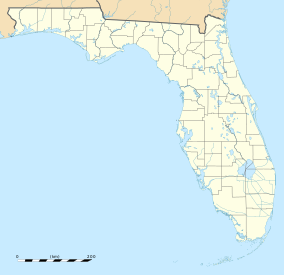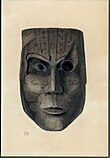| Letchworth Mounds Archaeological State Park | |
|---|---|
| IUCN category V (protected landscape/seascape) | |
 Entrance to the park Entrance to the park | |
  | |
| Location | Jefferson County, Florida, USA |
| Nearest city | Monticello, Florida |
| Coordinates | 30°31′04″N 83°59′30″W / 30.5176869°N 83.9916207°W / 30.5176869; -83.9916207 |
| Governing body | Florida Department of Environmental Protection |
Letchworth Mounds Archaeological State Park (8LE337) is a 188.2 acre Florida State Park that preserves the state's tallest prehistoric, Native American ceremonial earthwork mound, which is 46 feet (14 m) high. It is estimated to have been built 1100 to 1800 years ago. This is one of three major surviving mound complexes in the Florida Panhandle. The people who built the mound are believed to have been members of the Swift Creek Culture, a group of Native Americans who lived in North Florida between 200 and 450 A.D. The hierarchical society planned and constructed massive earthwork mounds as expression of its religious and political system.
The archeological park has exhibits to interpret the artifacts and evidence of nearly 10,000 years of human habitation found at this site. It is located approximately six miles west of Monticello, a half mile south of U.S. 90, in northwestern Florida. The address is 4500 Sunray Road South.
Two related sites in the panhandle are from the later Fort Walton Culture (1100-1550 CE): Fort Walton Mound, a National Historic Landmark; and the Lake Jackson Mounds Archaeological State Park.
Recreational activities
The mound has been preserved within a large natural area, which supports such activities as birding, hiking, picnicking and wildlife viewing.
Mound
Although the mound now has trees and underbrush growing from it, when originally built, such earthwork mounds were typically clear of vegetation, with smooth prepared sides. Many workers had to bring soils by basket to build the mound. The builders used their knowledge to combine a variety of soils and shells for stability, and usually finished the top and sides with clay.
The mound likely rose from flat plazas which were intentionally leveled. They would have served as gathering places for rituals, games and major occasions. The community of which such a tall mound was likely the center would have included nearby dwellings for workers, and communal fields and gardens. They cultivated maize to support the population density of such complex societies. The Letchworth Mounds site has one of the largest mounds from any site. The mound measures 300 feet in width and has a height between 46 and 50 feet.
This is one of three sites with mounds in the Florida Panhandle. The other two both date from the later Fort Walton Culture (1100-1550 CE).
See also
- List of Mississippian sites - Mississippian cultures
- List of burial mounds in the United States
References
External links
| Archaeological cultures | |
|---|---|
| Archaeological sites | 
|
| Human remains |
|
| Miscellaneous | |
| |
| Pre-Columbian North America | |
|---|---|
| Archaeological cultures |
|
| Archaeological sites |
|
| Human remains | |
| Miscellaneous |
|
| |
| Protected areas of Florida | |||||||||||||||||||||||||
|---|---|---|---|---|---|---|---|---|---|---|---|---|---|---|---|---|---|---|---|---|---|---|---|---|---|
| |||||||||||||||||||||||||
| |||||||||||||||||||||||||
| |||||||||||||||||||||||||